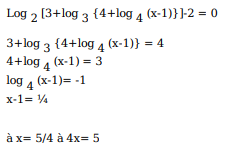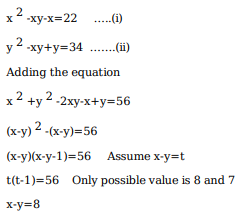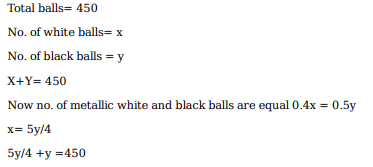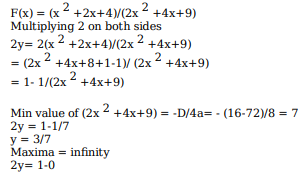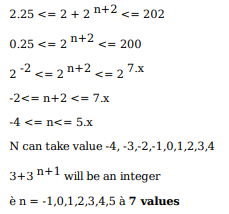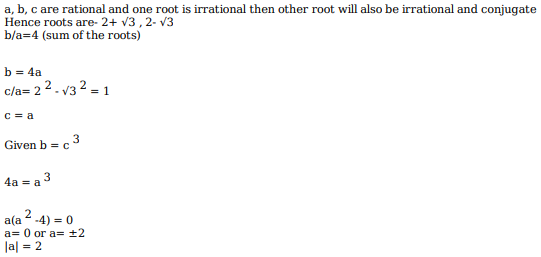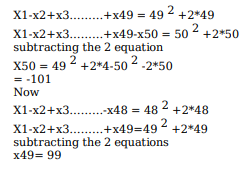Live Updates
• CATKing has launched new chat bot.

• New video on Logs has been released.
495
Learners
asked the doubt

Previous Year Questions
The passage below is accompanied by a set of questions. Choose the best answer to each question.
It has been said that knowledge, or the problem of knowledge, is the scandal of philosophy. The scandal is philosophy's apparent inability to show how, when and why we can be sure that we know something or, indeed, that we know anything. Philosopher Michael Williams writes: 'Is it possible to obtain knowledge at all? This problem is pressing because there are powerful arguments, some very ancient, for the conclusion that it is not . . . Scepticism is the skeleton in Western rationalism's closet'. While it is not clear that the scandal matters to anyone but philosophers, philosophers point out that it should matter to everyone, at least given a certain conception of knowledge. For, they explain, unless we can ground our claims to knowledge as such, which is to say, distinguish it from mere opinion, superstition, fantasy, wishful thinking, ideology, illusion or delusion, then the actions we take on the basis of presumed knowledge – boarding an airplane, swallowing a pill, finding someone guilty of a crime – will be irrational and unjustifiable.
That is all quite serious-sounding but so also are the rattlings of the skeleton: that is, the sceptic's contention that we cannot be sure that we know anything – at least not if we think of knowledge as something like having a correct mental representation of reality, and not if we think of reality as something like things-as-they-are-in-themselves, independent of our perceptions, ideas or descriptions. For, the sceptic will note, since reality, under that conception of it, is outside our ken (we cannot catch a glimpse of things-in-themselves around the corner of our own eyes; we cannot form an idea of reality that floats above the processes of our conceiving it), we have no way to compare our mental representations with things-as-they-are-in-themselves and therefore no way to determine whether they are correct or incorrect. Thus the sceptic may repeat (rattling loudly), you cannot be sure you 'know' something or anything at all – at least not, he may add (rattling softly before disappearing), if that is the way you conceive 'knowledge'.
There are a number of ways to handle this situation. The most common is to ignore it. Most people outside the academy – and, indeed, most of us inside it – are unaware of or unperturbed by the philosophical scandal of knowledge and go about our lives without too many epistemic anxieties. We hold our beliefs and presumptive knowledges more or less confidently, usually depending on how we acquired them (I saw it with my own eyes; I heard it on Fox News; a guy at the office told me) and how broadly and strenuously they seem to be shared or endorsed by various relevant people: experts and authorities, friends and family members, colleagues and associates. And we examine our convictions more or less closely, explain them more or less extensively, and defend them more or less vigorously, usually depending on what seems to be at stake for ourselves and/or other people and what resources are available for reassuring ourselves or making our beliefs credible to others (look, it's right here on the page; add up the figures yourself; I happen to be a heart specialist).
The author of the passage is most likely to support which one of the following statements?
Video Explanation

Explanatory Answer
Option A states that the confidence with which we maintain something to be true is 'usually independent of the source' of the alleged truth. This is the exact opposite of what the passage states in the last few lines: ' And we examine our convictions more or less closely, explain them more or less extensively, and defend them more or less vigorously, usually depending on .... what resources are available for reassuring ourselves or making our beliefs credible to others (look, it's right here on the page; add up the figures yourself; I happen to be a heart specialist).'
Option B states that if we are confident that knowledge is 'widely held', then actions taken on the basis of presumed knowledge become rational and justifiable. This is not what the passage says. The passage states that unless we distinguish knowledge from opinion, wishful thinking or delusion, the actions we take on the basis of presumed knowledge will be irrational and unjustifiable.
Option C sums up the main idea of the second paragraph:'For, the sceptic will note, since reality, under that conception of it, is outside our ken, we have no way to compare our mental representations with things-as-they-are-in-themselves and therefore no way to determine whether they are correct or incorrect.'The author is hence likely to support statement C.
According to the passage, the sceptic questions our ability to know 'reality' defined as things-as-they-are-in-themselves, independent of our perceptions, ideas or descriptions because 'it floats above the processes of our conceiving it'.
Option D states that the sceptic would advocate knowing reality independently. This is incorrect.
". . . we cannot catch a glimpse of things-in-themselves around the corner of our own eyes; we cannot form an idea of reality that floats above the processes of our conceiving it . . ." Which one of the following statements best reflects the argument being made in this sentence?
Video Explanation

Explanatory Answer
The argument being made here is that if reality is independent of our perceptions, ideas or descriptions, then it is clearly out of our scope of understanding, as it exists outside our ability to conceive or perceive it. Option B is hence the right choice.
According to the last paragraph of the passage, "We hold our beliefs and presumptive knowledges more or less confidently, usually depending on" something. Which one of the following most broadly captures what we depend on?
Video Explanation

Explanatory Answer
A straightforward question. Note what the passage states: ‘We hold our beliefs and presumptive knowledges more or less confidently, usually depending on how we acquired them (I saw it with my own eyes; I heard it on Fox News; a guy at the office told me) and how broadly and strenuously they seem to be shared or endorsed by various relevant people: experts and authorities, friends and family members, colleagues and associates.
Note that option B relates to factors based on which we examine or defend our convictions. Option C does not relate to the question.
The author discusses all of the following arguments in the passage, EXCEPT:
Video Explanation

Explanatory Answer
Note the ‘except’ in the question. The answer option is one that is not an argument made by the author. The author says that the ‘most common’ way of dealing with scepticism about the veracity of knowledge is to ignore it.
Option B states that it is ‘the best way’ . So, option B is not an argument made by the author.
All other options relate to what is discussed in the passage:
Option A- ‘unless we can ground our claims to knowledge as such, which is to say, distinguish it from mere opinion, superstition, fantasy, wishful thinking, ideology, illusion or delusion, then the actions we take on the basis of presumed knowledge – boarding an airplane, swallowing a pill, finding someone guilty of a crime – will be irrational and unjustifiable.’
Option C-’While it is not clear that the scandal matters to anyone but philosophers, philosophers point out that it should matter to everyone, at least given a certain conception of knowledge.’
Option D- ‘Thus the sceptic may repeat (rattling loudly), you cannot be sure you 'know' something or anything at all – at least not, he may add (rattling softly before disappearing), if that is the way you conceive' 'knowledge'’.
The passage below is accompanied by a set of questions. Choose the best answer to each question.
It's easy to forget that most of the world's languages are still transmitted orally with no widely established written form. While speech communities are increasingly involved in projects to protect their languages – in print, on air and online – orality is fragile and contributes to linguistic vulnerability. But indigenous languages are about much more than unusual words and intriguing grammar: They function as vehicles for the transmission of cultural traditions, environmental understandings and knowledge about medicinal plants, all at risk when elders die and livelihoods are disrupted.
Both push and pull factors lead to the decline of languages. Through war, famine and natural disasters, whole communities can be destroyed, taking their language with them to the grave, such as the indigenous populations of Tasmania who were wiped out by colonists. More commonly, speakers live on but abandon their language in favor of another vernacular, a widespread process that linguists refer to as "language shift" from which few languages are immune. Such trading up and out of a speech form occurs for complex political, cultural and economic reasons – sometimes voluntary for economic and educational reasons, although often amplified by state coercion or neglect. Welsh, long stigmatized and disparaged by the British state, has rebounded with vigor.
Many speakers of endangered, poorly documented languages have embraced new digital media with excitement. Speakers of previously exclusively oral tongues are turning to the web as a virtual space for languages to live on. Internet technology offers powerful ways for oral traditions and cultural practices to survive, even thrive, among increasingly mobile communities. I have watched as videos of traditional wedding ceremonies and songs are recorded on smartphones in London by Nepali migrants, then uploaded to YouTube and watched an hour later by relatives in remote Himalayan villages . . .
Globalization is regularly, and often uncritically, pilloried as a major threat to linguistic diversity. But in fact, globalization is as much process as it is ideology, certainly when it comes to language. The real forces behind cultural homogenization are unbending beliefs, exchanged through a globalized delivery system, reinforced by the historical monolingualism prevalent in much of the West.
Monolingualism – the condition of being able to speak only one language – is regularly accompanied by a deep-seated conviction in the value of that language over all others. Across the largest economies that make up the G8, being monolingual is still often the norm, with multilingualism appearing unusual and even somewhat exotic. The monolingual mindset stands in sharp contrast to the lived reality of most the world, which throughout its history has been more multilingual than unilingual. Monolingualism, then, not globalization, should be our primary concern.
Multilingualism can help us live in a more connected and more interdependent world. By widening access to technology, globalization can support indigenous and scholarly communities engaged in documenting and protecting our shared linguistic heritage. For the last 5,000 years, the rise and fall of languages was intimately tied to the plow, sword and book. In our digital age, the keyboard, screen and web will play a decisive role in shaping the future linguistic diversity of our species.
From the passage, we can infer that the author is in favour of:
Video Explanation

Explanatory Answer
In the last two paragraphs, the passage speaks of the problems that arise due to monolingualism and the advantages of multilingualism. According to the passage, ‘Multilingualism can help us live in a more connected and more interdependent world.’. So, the correct choice is option D.
The author lists all of the following as reasons for the decline or disappearance of a language EXCEPT:
Video Explanation

Explanatory Answer
The second paragraph details the reasons for decline of languages: 'through war, famine and natural disasters', and language shift 'for complex political, cultural and economic reasons – sometimes voluntary for economic and educational reasons, although often amplified by state coercion or neglect'. Options B, C and D cover these points.
The passage does not attribute the decline of languages to internet use. So, option A is the correct answer choice.
The author mentions the Welsh language to show that:
Video Explanation

Explanatory Answer
The passage states that ‘Welsh, long stigmatized and disparaged by the British state, has rebounded with vigor’. Here, the author cites the example of Welsh to show that languages can bounce back after a forced language shift.
We can infer all of the following about indigenous languages from the passage EXCEPT that:
Video Explanation

Explanatory Answer
In the first paragraph, the passage states that indigenous languages ‘function as vehicles for the transmission of cultural traditions, environmental understandings and knowledge about medicinal plants’, that ‘ speech communities are increasingly involved in projects to protect their languages – in print, on air and online’ and that ‘most of the world's languages are still transmitted orally with no widely established written form’.
So, options B, C and D can be inferred from the passage.
Though the passage states that indigenous languages have ‘unusual words and intriguing grammar’, it does not say that this makes these languages challenging to document. Option A cannot be inferred from the passage.
The passage below is accompanied by a set of questions. Choose the best answer to each question.
I have elaborated . . . a framework for analyzing the contradictory pulls on [Indian] nationalist ideology in its struggle against the dominance of colonialism and the resolution it offered to those contradictions. Briefly, this resolution was built around a separation of the domain of culture into two spheres—the material and the spiritual. It was in the material sphere that the claims of Western civilization were the most powerful. Science, technology, rational forms of economic organization, modern methods of statecraft—these had given the European countries the strength to subjugate the non-European people . . . To overcome this domination, the colonized people had to learn those superior techniques of organizing material life and incorporate them within their own cultures. . . . But this could not mean the imitation of the West in every aspect of life, for then the very distinction between the West and the East would vanish—the self-identity of national culture would itself be threatened. . . .
The discourse of nationalism shows that the material/spiritual distinction was condensed into an analogous, but ideologically far more powerful, dichotomy: that between the outer and the inner. . . . Applying the inner/outer distinction to the matter of concrete day-to-day living separates the social space into ghar and bahir, the home and the world. The world is the external, the domain of the material; the home represents one's inner spiritual self, one's true identity. The world is a treacherous terrain of the pursuit of material interests, where practical considerations reign supreme. It is also typically the domain of the male. The home in its essence must remain unaffected by the profane activities of the material world—and woman is its representation. And so one gets an identification of social roles by gender to correspond with the separation of the social space into ghar and bahir. . . .
The colonial situation, and the ideological response of nationalism to the critique of Indian tradition, introduced an entirely new substance to [these dichotomies] and effected their transformation. The material/spiritual dichotomy, to which the terms world and home corresponded, had acquired . . . a very special significance in the nationalist mind. The world was where the European power had challenged the non-European peoples and, by virtue of its superior material culture, had subjugated them. But, the nationalists asserted, it had failed to colonize the inner, essential, identity of the East which lay in its distinctive, and superior, spiritual culture. . . . [I]n the entire phase of the national struggle, the crucial need was to protect, preserve and strengthen the inner core of the national culture, its spiritual essence. . . .
Once we match this new meaning of the home/world dichotomy with the identification of social roles by gender, we get the ideological framework within which nationalism answered the women's question. It would be a grave error to see in this, as liberals are apt to in their despair at the many marks of social conservatism in nationalist practice, a total rejection of the West. Quite the contrary: the nationalist paradigm in fact supplied an ideological principle of selection.
Which one of the following, if true, would weaken the author's claims in the passage?
Video Explanation

Explanatory Answer
According to the author, during the national struggle, nationalists maintained that European power had 'failed to colonize the inner, essential, identity of the East which lay in its distinctive, and superior, spiritual culture'. If, as mentioned in option D, the colonial period saw the hybridisation of Indian culture in all realms-- if there were no home/world dichotomy on which the author bases his argument-- then, that would seriously weaken the author's claims in the passage.
In the last paragraph, the author says that it would be a grave error to think that the ideological framework within which nationalism answered 'the women's question' did not mean a total rejection of the West. This implies the nationalists embraced some aspects of the West and rejected some aspects, selectively. If option A were true and Indian nationalists rejected the cause of English education for women, that would really not weaken the author's claims in any way.
The author argues that colonial modernity, in terms of science, technology, rational forms of economic organization, and modern methods of statecraft 'had given the European countries the strength to subjugate the non-European people'. It was this domination that the colonized people were trying to overcome. So, option B, if true, strengthens the author's claims in the passage.
Just like option B, option C, if true, strengthens the author's claim that in the material realm, the European powers were ahead and this in turn gave them the strength to subjugate non-European people.
Which one of the following best describes the liberal perception of Indian nationalism?
Video Explanation

Explanatory Answer
In the matching of the home/world dichotomy with gender-based social roles, the liberals are apt to (likely to), according to the author, see a total rejection of the West by Indian nationalists : ‘It would be a grave error to see in this, as liberals are apt to in their despair at the many marks of social conservatism in nationalist practice, a total rejection of the West.’ In other words, in the liberals’ view Indian nationalist discourses reaffirmed traditional gender roles for Indian women.
On the basis of the information in the passage, all of the following are true about the spiritual/material dichotomy of Indian nationalism EXCEPT that it:
Video Explanation

Explanatory Answer
In the second paragraph, the author talks about the material/spiritual dichotomy and states that it 'was condensed into an analogous, but ideologically far more powerful, dichotomy: that between the outer and the inner'. So, option D is true. The author also states that 'Applying the inner/outer distinction to the matter of concrete day-to-day living separates the social space into ghar and bahir, the home and the world'. So, option B is also true.
In the third paragraph, the author elaborates on how the material/spiritual dichotomy acquired 'a very special significance in the nationalist mind', as the nationalists asserted that the West 'had failed to colonize the inner, essential, identity of the East which lay in its distinctive, and superior, spiritual culture'. In other words, the spiritual/material dichotomy helped in safeguarding the identity of Indian nationalism. So, option A is true.
On the other hand, nowhere in the passage does the author say as mentioned in option C that the spiritual/material dichotomy was a 'continuation of age-old oppositions in Indian culture'.
Which one of the following explains the "contradictory pulls" on Indian nationalism?
Video Explanation

Explanatory Answer
The author begins the passage by describing the 'contradictory pulls' on Indian nationalist ideology. In science, technology, economic organization and modern methods of statecraft, the West dominated. In fact, to overcome this domination, instead of fighting the colonialists on this front, colonized people 'had to learn those superior techniques of organizing material life and incorporate them within their own cultures'. In other words, despite its fight against colonial domination, Indian nationalism had adopt Western ideas in the material sphere.
The passage below is accompanied by a set of questions. Choose the best answer to each question.
Many people believe that truth conveys power. . . . Hence sticking with the truth is the best strategy for gaining power. Unfortunately, this is just a comforting myth. In fact, truth and power have a far more complicated relationship, because in human society, power means two very different things.
On the one hand, power means having the ability to manipulate objective realities: to hunt animals, to construct bridges, to cure diseases, to build atom bombs. This kind of power is closely tied to truth. If you believe a false physical theory, you won't be able to build an atom bomb. On the other hand, power also means having the ability to manipulate human beliefs, thereby getting lots of people to cooperate effectively. Building atom bombs requires not just a good understanding of physics, but also the coordinated labor of millions of humans. Planet Earth was conquered by Homo sapiens rather than by chimpanzees or elephants, because we are the only mammals that can cooperate in very large numbers. And large-scale cooperation depends on believing common stories. But these stories need not be true. You can unite millions of people by making them believe in completely fictional stories about God, about race or about economics. The dual nature of power and truth results in the curious fact that we humans know many more truths than any other animal, but we also believe in much more nonsense. . . .
When it comes to uniting people around a common story, fiction actually enjoys three inherent advantages over the truth. First, whereas the truth is universal, fictions tend to be local. Consequently if we want to distinguish our tribe from foreigners, a fictional story will serve as a far better identity marker than a true story. . . . The second huge advantage of fiction over truth has to do with the handicap principle, which says that reliable signals must be costly to the signaler. Otherwise, they can easily be faked by cheaters. . . . If political loyalty is signaled by believing a true story, anyone can fake it. But believing ridiculous and outlandish stories exacts greater cost, and is therefore a better signal of loyalty. . . . Third, and most important, the truth is often painful and disturbing. Hence if you stick to unalloyed reality, few people will follow you. An American presidential candidate who tells the American public the truth, the whole truth and nothing but the truth about American history has a 100 percent guarantee of losing the elections. . . . An uncompromising adherence to the truth is an admirable spiritual practice, but it is not a winning political strategy. . . .
Even if we need to pay some price for deactivating our rational faculties, the advantages of increased social cohesion are often so big that fictional stories routinely triumph over the truth in human history. Scholars have known this for thousands of years, which is why scholars often had to decide whether they served the truth or social harmony. Should they aim to unite people by making sure everyone believes in the same fiction, or should they let people know the truth even at the price of disunity?
Regarding which one of the following quotes could we argue that the author overemphasises the importance of fiction?
Video Explanation

Explanatory Answer
Of the given options, the quote that stresses on the importance of fiction most strongly is option A. Here, the author more or less equates fiction with unity and truth with disunity. Option B is less about overemphasizing the importance of fiction than about disparaging the power of truth. Options C and D are expository and neither of these overemphasises the importance of fiction.
The central theme of the passage is about the choice between:
Video Explanation

Explanatory Answer
The central idea of the passage is that when it comes to uniting people around a common story, fiction has several advantages over objective truth. The author states that ‘Even if we need to pay some price for deactivating our rational faculties, the advantages of increased social cohesion are often so big that fictional stories routinely triumph over the truth in human history’.
So, option C is the right choice.
Note that the passage is not about the choice between truth and power. The author states truth doesn’t always convey power and talks about the ‘complicated’ relationship between the two.
The author implies that, like scholars, successful leaders:
Video Explanation

Explanatory Answer
According to the author, scholars have known for thousands of years that ‘the advantages of increased social cohesion are often so big that fictional stories routinely triumph over the truth in human history’ and that this is ‘why scholars often had to decide whether they served the truth or social harmony’. Here, the author implies that scholars know how to balance truth on the one hand and social unity on the other.
The author would support none of the following statements about political power EXCEPT that:
Video Explanation

Explanatory Answer
According to the author, ‘An uncompromising adherence to the truth is an admirable spiritual practice, but it is not a winning political strategy’. In other words, leaders retain power by not sticking to the unvarnished truth, but by deviating from it.
Five jumbled up sentences, related to a topic, are given below. Four of them can be put together to form a coherent paragraph. Identify the odd one out and key in the number of the sentence as your answer:
1. The care with which philosophers examine arguments for and against forms of biotechnology makes this an excellent primer on formulating and assessing moral arguments.
2. Although most people find at least some forms of genetic engineering disquieting, it is not easy to articulate why: what is wrong with re-engineering our nature?
3. Breakthroughs in genetics present us with the promise that we will soon be able to prevent a host of debilitating diseases, and the predicament that our newfound genetic knowledge may enable us to enhance our genetic traits.
4. To grapple with the ethics of enhancement, we need to confront questions that verge on theology, which is why modern philosophers and political theorists tend to shrink from them.
5. One argument is that the drive for human perfection through genetics is objectionable as it represents a bid for mastery that fails to appreciate the gifts of human powers and achievements.
Video Explanation

Explanatory Answer
Sentences 2 and 5 form a unit: 5 answers the question posed in 2. In the same way 3 and 4 form a unit. But while these four sentences focus on genetic engineering – the promise it offers on the one hand and the ethical predicament it presents on the other, sentence 1 talks about a slightly different, broader discipline– biotechnology– and a different idea – how the examination of biotechnology by philosophers may help formulate and assess moral arguments.
Sentence 1 is hence the odd one out.
The passage given below is followed by four alternate summaries. Choose the option that best captures the essence of the passage.
The unlikely alliance of the incumbent industrialist and the distressed unemployed worker is especially powerful amid the debris of corporate bankruptcies and layoffs. In an economic downturn, the capitalist is more likely to focus on costs of the competition emanating from free markets than on the opportunities they create. And the unemployed worker will find many others in a similar condition and with anxieties similar to his, which will make it easier for them to organize together. Using the cover and the political organization provided by the distressed, the capitalist captures the political agenda.
Video Explanation

Explanatory Answer
The main idea of the paragraph is that, in an economic downturn, the capitalist, worried about the cost of competition arising from free markets, finds that he can ally with the distressed unemployed workers and use the cover and the political organization provided by them to capture the political agenda.
Option B sums up the paragraph well.
Option A implies that it is the goal of the unemployed, too, to stifle competition in free markets. This is incorrect. Similarly, C implies the unemployed capture the political agenda along with the capitalist. That is not what the paragraph states. Option D is not in line with the main idea of the paragraph either.
The four sentences (labelled 1, 2, 3 and 4) below, when properly sequenced would yield a coherent paragraph. Decide on the proper sequencing of the order of the sentences and key in the sequence of the four numbers as your answer:
1. The US has long maintained that the Northwest Passage is an international strait through which its commercial and military vessels have the right to pass without seeking Canada's permission.
2. Canada, which officially acquired the group of islands forming the Northwest Passage in 1880, claims sovereignty over all the shipping routes through the Passage.
3. The dispute could be transitory, however, as scientists speculate that the entire Arctic Ocean will soon be ice-free in summer, so ship owners will not have to ask for permission to sail through any of the Northwest Passage routes.
4. The US and Canada have never legally settled the question of access through the Passage, but have an agreement whereby the US needs to seek Canada's consent for any transit.
Video Explanation

Explanatory Answer
Sentence 2 is the best opening sentence, as it explains what the Northwest Passage is (a group of islands acquired by Canada in 1880). Sentence 1 relates to 2, presenting the US position on Canada’s claim of sovereignty over all shipping routes through the Passage.
This leads on to the idea in sentence 4– both countries have not legally settled the question of access through the Passage yet. Sentence 3 concludes the paragraph explaining how the dispute could turn out to be transitory due to the Arctic Ocean turning ice-free in summer. So, 2143 is the correct order.
The four sentences (labelled 1, 2, 3, 4) below, when properly sequenced would yield a coherent paragraph. Decide on the proper sequencing of the order of the sentences and key in the sequence of the four numbers as your answer:
1. But today there is an epochal challenge to rethink and reconstitute the vision and practice of development as a shared responsibility – a sharing which binds both the agent and the audience, the developed world and the developing, in a bond of shared destiny.
2. We are at a crossroads now in our vision and practice of development.
3. This calls for the cultivation of an appropriate ethical mode of being in our lives which enables us to realize this global and planetary situation of shared living and responsibility.
4. Half a century ago, development began as a hope for a better human possibility, but in the last fifty years, this hope has lost itself in the dreary desert of various kinds of hegemonic applications.
Video Explanation

Explanatory Answer
Sentence 2 states the main idea of the passage and is the best opening sentence. 41 is a unit:
sentence 4 explains how development began half a century ago and how it lost its way.
Sentence 1 explains the view on the vision and practice of development today.
Sentence 3 carries forward the idea in 2 and states what the rethink and reconstitution of development entails.
So, 2413 is the correct order.
Five jumbled up sentences, related to a topic, are given below. Four of them can be put together to form a coherent paragraph. Identify the odd one out and key in the number of the sentence as your answer:
1. It has taken on a warm, fuzzy glow in the advertising world, where its potential is being widely discussed, and it is being claimed as the undeniable wave of the future.
2. There is little enthusiasm for this in the scientific arena; for them marketing is not a science, and only a handful of studies have been published in scientific journals.
3. The new, growing field of neuromarketing attempts to reveal the inner workings of consumer behaviour and is an extension of the study of how choices and decisions are made.
4. Some see neuromarketing as an attempt to make the "art" of advertising into a science, being used by marketing experts to back up their proposals with some form of real data.
5. The marketing gurus have already started drawing on psychology in developing tests and theories, and advertising people have borrowed the idea of the focus group from social scientists.
Video Explanation

Explanatory Answer
While all other sentences relate to neuromarketing and how it has been received by marketers, advertisers and scientists, sentence 5 is about an unrelated idea – how marketers and advertisers have started drawing on science/scientific methods in developing tests and theories.
3412 makes a cogent paragraph;
5 is the odd one out.
The four sentences (labelled 1, 2, 3 and 4) below, when properly sequenced would yield a coherent paragraph. Decide on the proper sequencing of the order of the sentences and key in the sequence of the four numbers as your answer:
1. Look forward a few decades to an invention which can end the energy crisis, change the global economy and curb climate change at a stroke: commercial fusion power.
2. To gain meaningful insights, logic has to be accompanied by asking probing questions of nature through controlled tests, precise observations and clever analysis.
3. The greatest of all inventions is the über-invention that has provided the insights on which others depend: the modern scientific method.
4. This invention is inconceivable without the scientific method; it will rest on the application of a diverse range of scientific insights, such as the process transforming hydrogen into helium to release huge amounts of energy.
Video Explanation

Explanatory Answer
Sentence 3 introduces the main idea of the paragraph; so it is the opening sentence.
32 is a unit: 2 explains the term ‘modern scientific method’ mentioned in 3.
14 is also a unit: sentence 1 talks about a new invention, commercial fusion power and 4 explains how the scientific method is key to this invention.
3214 forms a cogent paragraph.
The passage given below is followed by four alternate summaries. Choose the option that best captures the essence of the passage.
Biologists who publish their research directly to the Web have been labelled as "rogue", but physicists have been routinely publishing research digitally ("preprints"), prior to submitting in a peer-reviewed journal. Advocates of preprints argue that quick and open dissemination of research speeds up scientific progress and allows for wider access to knowledge. But some journals still don't accept research previously published as a preprint. Even if the idea of preprints is gaining ground, one of the biggest barriers for biologists is how they would be viewed by members of their conservative research community.
Video Explanation

Explanatory Answer
The main idea of the given paragraph is that, while physicists routinely pre-publish research in order to speed up scientific progress and allow access to knowledge, the conservative research community of biologists is less accepting of the idea. Option B sums up the paragraph well.
Option A states the exact opposite of what the paragraph says about biologists.
Option C is incorrect as it says 'almost all peer-reviewed journals' are reluctant to accept pre-prints. The paragraph does not say so.
Like C, D over-generalizes, saying that preprints are not accepted by 'most' scientific communities.
The passage given below is followed by four alternate summaries. Choose the option that best captures the essence of the passage.
Creativity is now viewed as the engine of economic progress. Various organizations are devoted to its study and promotion; there are encyclopedias and handbooks surveying creativity research. But this proliferating success has tended to erode creativity's stable identity: it has become so invested with value that it has become impossible to police its meaning and the practices that supposedly identify and encourage it. Many people and organizations committed to producing original thoughts now feel that undue obsession with the idea of creativity gets in the way of real creativity.
Video Explanation

Explanatory Answer
According to the paragraph, the undue obsession with the idea of creativity today is actually getting in the way of real creativity. Option B sums up the paragraph well.
While the paragraph talks about the obsession with the idea of creativity and how that is hampering creativity, Option A talks of the obsession with 'original thought' making it difficult to define the concept. This is incorrect.
Option C blames the industry that has built up researching creativity for the destruction of the creative process. This is too extreme and not what the paragraph says.
Option D says that the proliferation of creativity has stifled the creative process. This is incorrect.
Ten objects o1, o2, …, o10 were distributed among Amar, Barat, Charles, Disha, and Elise. Each item went to exactly one person. Each person got exactly two of the items, and this pair of objects is called her/his bundle.
The following table shows how each person values each object.
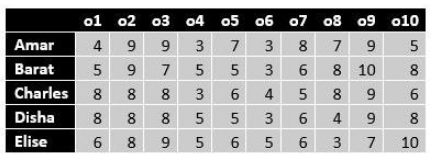
The value of any bundle by a person is the sum of that person's values of the objects in that bundle. A person X envies another person Y if X values Y's bundle more than X's own bundle.
For example, hypothetically suppose Amar's bundle consists of o1 and o2, and Barat's bundle consists of o3 and o4. Then Amar values his own bundle at 4 + 9 = 13 and Barat's bundle at 9 + 3 = 12. Hence Amar does not envy Barat. On the other hand, Barat values his own bundle at 7 + 5 = 12 and Amar's bundle at 5 + 9 = 14. Hence Barat envies Amar.
The following facts are known about the actual distribution of the objects among the five people.
1. If someone's value for an object is 10, then she/he received that object.
2. Objects o1, o2, and o3 were given to three different people.
3. Objects o1 and o8 were given to different people.
4. Three people value their own bundles at 16. No one values her/his own bundle at a number higher than 16.
5. Disha values her own bundle at an odd number. All others value their own bundles at an even number.
6. Some people who value their own bundles less than 16 envy some other people who value their own bundle at 16. No one else envies others.
What BEST can be said about object o8?
Video Explanation

Explanatory Answer
Who among the following envies someone else?
Video Explanation

Explanatory Answer
What BEST can be said about the distribution of object o1?
Video Explanation

Explanatory Answer
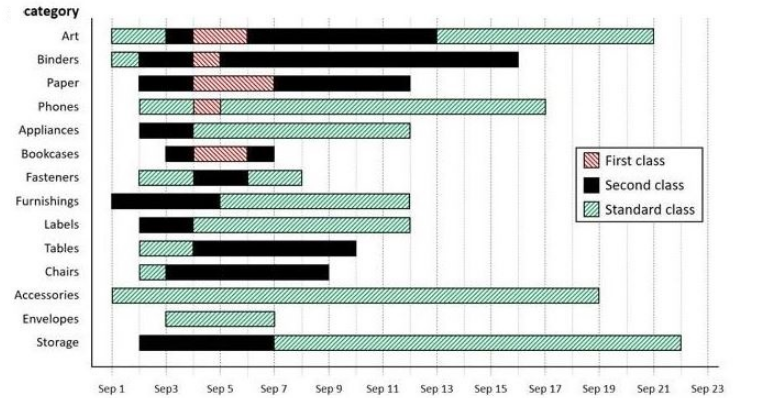
The different bars in the diagram above provide information about different orders in various categories (Art, Binders, ….) that were booked in the first two weeks of September of a store for one client. The colour and pattern of a bar denotes the ship mode (First Class / Second Class / Standard Class). The left end point of a bar indicates the booking day of the order, while the right end point indicates the dispatch day of the order. The difference between the dispatch day and the booking day (measured in terms of the number of days) is called the processing time of the order. For the same category, an order is considered for booking only after the previous order of the same category is dispatched. No two consecutive orders of the same category had identical ship mode during this period.
For example, there were only two orders in the furnishing category during this period. The first one was shipped in the Second Class. It was booked on Sep 1 and dispatched on Sep 5. The second order was shipped in the Standard class. It was booked on Sep 5 (although the order might have been placed before that) and dispatched on Sep 12. So the processing times were 4 and 7 days respectively for these orders.
How many days between Sep 1 and Sep 14 (both inclusive) had no booking from this client considering all the above categories?
Video Explanation

Explanatory Answer

We need to look for days which have no orderings starting on it.
We can see
September 8, 9, 10, 11, 12 & 14 have no bookings.
Hence, the answer to this question is 6.
What was the average processing time of all orders in the categories which had only one type of ship mode?
Video Explanation

Explanatory Answer

Accessories and envelopes are the only 2 categories which have only 1 shipping method
Their respective processing times are 18 and 4 days.
Total processing time = 18+4 = 22
Average = 22/2 = 11 Days
The sequence of categories -- Art, Binders, Paper and Phones -- in decreasing order of average processing time of their orders in this period is:
Video Explanation

Explanatory Answer

Art
Total processing time = 20 days
No of orders = 5
Avg processing time = 20/5 = 4 days
Binders
Total processing time = 15 days
No of orders = 4
Avg processing time = 15/4 = 3.75 days
Paper
Total processing time = 10 days
No of orders = 3
Avg processing time = 10/3 = 3.33 days
Phone
Total processing time = 15 days
No of orders = 3
Avg processing time = 15/3 = 5 days
Thus in decreasing order we get
Phone, Art, Binders, Paper
Approximately what percentage of orders had a processing time of one day during the period Sep 1 to Sep 22 (both dates inclusive)?
Video Explanation

Explanatory Answer

Total orders across categories = 35
Orders which had processing time of one day = 7% = (7/35) * 100 = 20%
The game of Chango is a game where two people play against each other; one of them wins and the other loses, i.e., there are no drawn Chango games. 12 players participated in a Chango championship. They were divided into four groups: Group A consisted of Aruna, Azul, and Arif; Group B consisted of Brinda, Brij, and Biju; Group C consisted of Chitra, Chetan, and Chhavi; and Group D consisted of Dipen, Donna, and Deb.
Players within each group had a distinct rank going into the championship. The players have NOT been listed necessarily according to their ranks. In the group stage of the game, the second and third ranked players play against each other, and the winner of that game plays against the first ranked player of the group. The winner of this second game is considered as the winner of the group and enters a semi-final.
The winners from Groups A and B play against each other in one semi-final, while the winners from Groups C and D play against each other in the other semi-final. The winners of the two semi-finals play against each other in the final to decide the winner of the championship.
It is known that:
1. Chitra did not win the championship.
2. Aruna did not play against Arif. Brij did not play against Brinda.
3. Aruna, Biju, Chitra, and Dipen played three games each, Azul and Chetan played two games each, and the remaining players played one game each.
Who among the following was DEFINITELY NOT ranked first in his/her group?
Video Explanation

Explanatory Answer
Which of the following pairs must have played against each other in the championship?
Video Explanation

Explanatory Answer
Who among the following did NOT play against Chitra in the championship?
Video Explanation

Explanatory Answer
Ravi works in an online food-delivery company. After each delivery, customers rate Ravi on each of four parameters – Behaviour, Packaging, Hygiene, and Timeliness, on a scale from 1 to 9. If the total of the four rating points is 25 or more, then Ravi gets a bonus of ₹20 for that delivery. Additionally, a customer may or may not give Ravi a tip. If the customer gives a tip, it is either ₹30 or ₹50.
One day, Ravi made four deliveries - one to each of Atal, Bihari, Chirag and Deepak, and received a total of ₹120 in bonus and tips. He did not get both a bonus and a tip from the same customer.
The following additional facts are also known.
1. In Timeliness, Ravi received a total of 21 points, and three of the customers gave him the same rating points in this parameter. Atal gave higher rating points than Bihari and Chirag in this parameter.
2. Ravi received distinct rating points in Packaging from the four customers adding up to 29 points. Similarly, Ravi received distinct rating points in Hygiene from the four customers adding up to 26 points.
3. Chirag gave the same rating points for Packaging and Hygiene.
4. Among the four customers, Bihari gave the highest rating points in Packaging, and Chirag gave the highest rating points in Hygiene.
5. Everyone rated Ravi between 5 and 7 in Behaviour. Unique maximum and minimum ratings in this parameter were given by Atal and Deepak respectively.
6. If the customers are ranked based on ratings given by them in individual parameters, then Atal's rank based on Packaging is the same as that based on Hygiene. This is also true for Deepak.
What was the minimum rating that Ravi received from any customer in any parameter?
Video Explanation

Explanatory Answer
The COMPLETE list of customers who gave the maximum total rating points to Ravi is
Video Explanation

Explanatory Answer
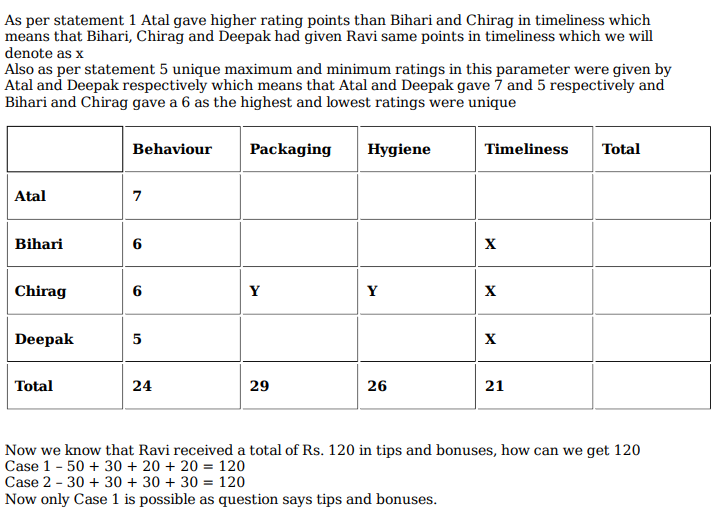
Now how can we uniquely get 29 and 26
For 29: 5+7+8+9 = 29
For 26:
5+6+7+8 = 26
4+5+8+9 = 26
4+6+7+9 = 26
As per statement 4 Bihari gave the highest rating points in Packaging, and Chirag gave the highest rating points in Hygiene.
So Bihari gives Ravi a 9 in packaging which means the highest points in Hygiene can be 8 only as Chirag gives the highest points in Hygiene and he gives the same score in packaging too.
Also per statement 6 Atal’s rank based on Packaging is the same as that based on Hygiene. This is also true for Deepak, this means that Bihari will be second in Hygiene and thus gives 7 points
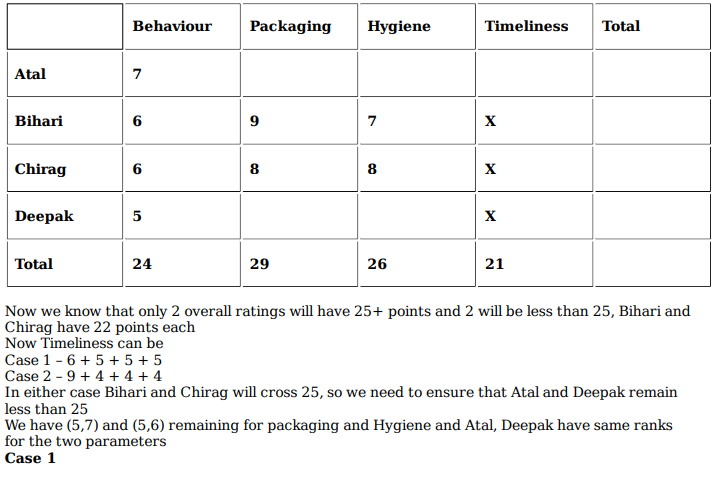
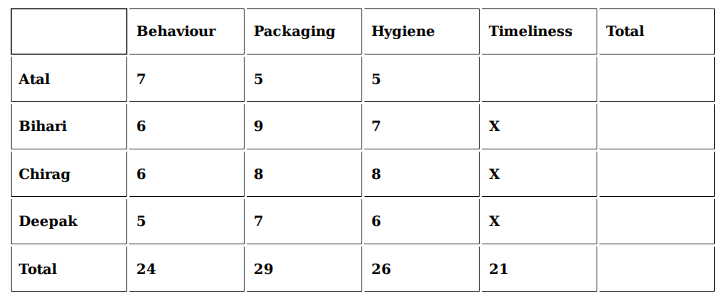
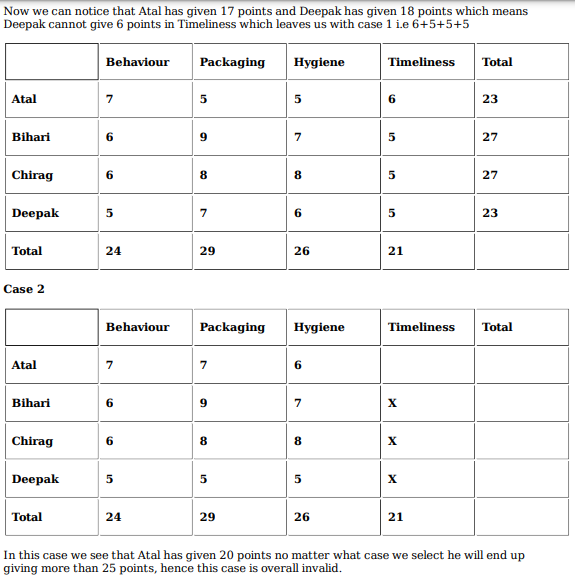
What rating did Atal give on Timeliness?
Video Explanation

Explanatory Answer

Now how can we uniquely get 29 and 26
For 29: 5+7+8+9 = 29
For 26:
5+6+7+8 = 26
4+5+8+9 = 26
4+6+7+9 = 26
As per statement 4 Bihari gave the highest rating points in Packaging, and Chirag gave the highest rating points in Hygiene.
So Bihari gives Ravi a 9 in packaging which means the highest points in Hygiene can be 8 only as Chirag gives the highest points in Hygiene and he gives the same score in packaging too.
Also per statement 6 Atal’s rank based on Packaging is the same as that based on Hygiene. This is also true for Deepak, this means that Bihari will be second in Hygiene and thus gives 7 points



What BEST can be concluded about the tip amount given by Deepak?
Video Explanation

Explanatory Answer

Now how can we uniquely get 29 and 26
For 29: 5+7+8+9 = 29
For 26:
5+6+7+8 = 26
4+5+8+9 = 26
4+6+7+9 = 26
As per statement 4 Bihari gave the highest rating points in Packaging, and Chirag gave the highest rating points in Hygiene.
So Bihari gives Ravi a 9 in packaging which means the highest points in Hygiene can be 8 only as Chirag gives the highest points in Hygiene and he gives the same score in packaging too.
Also per statement 6 Atal’s rank based on Packaging is the same as that based on Hygiene. This is also true for Deepak, this means that Bihari will be second in Hygiene and thus gives 7 points



In which parameter did Atal give the maximum rating points to Ravi?
Video Explanation

Explanatory Answer

Now how can we uniquely get 29 and 26
For 29: 5+7+8+9 = 29
For 26:
5+6+7+8 = 26
4+5+8+9 = 26
4+6+7+9 = 26
As per statement 4 Bihari gave the highest rating points in Packaging, and Chirag gave the highest rating points in Hygiene.
So Bihari gives Ravi a 9 in packaging which means the highest points in Hygiene can be 8 only as Chirag gives the highest points in Hygiene and he gives the same score in packaging too.
Also per statement 6 Atal’s rank based on Packaging is the same as that based on Hygiene. This is also true for Deepak, this means that Bihari will be second in Hygiene and thus gives 7 points



What rating did Deepak give on Packaging?
Video Explanation

Explanatory Answer

Now how can we uniquely get 29 and 26
For 29: 5+7+8+9 = 29
For 26:
5+6+7+8 = 26
4+5+8+9 = 26
4+6+7+9 = 26
As per statement 4 Bihari gave the highest rating points in Packaging, and Chirag gave the highest rating points in Hygiene.
So Bihari gives Ravi a 9 in packaging which means the highest points in Hygiene can be 8 only as Chirag gives the highest points in Hygiene and he gives the same score in packaging too.
Also per statement 6 Atal’s rank based on Packaging is the same as that based on Hygiene. This is also true for Deepak, this means that Bihari will be second in Hygiene and thus gives 7 points



The number of ways of distributing 15 identical balloons, 6 identical pencils and 3 identical erasers among 3 children, such that each child gets at least four balloons and one pencil, is
Video Explanation

Explanatory Answer
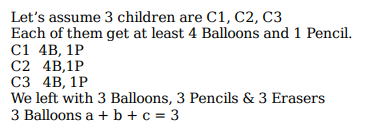
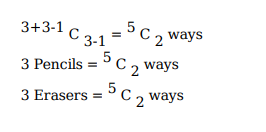

From a container filled with milk, 9 litres of milk are drawn and replaced with water. Next, from the same container, 9 litres are drawn and again replaced with water. If the volumes of milk and water in the container are now in the ratio of 16 : 9, then the capacity of the container, in litres, is
Video Explanation

Explanatory Answer
Let the initial quantity (Capacity of Container) = x
Milk / Total = 16/25 = [(x -9)/x] 2=> 4/5 = (x - 9)/x=> x = 45
Two trains A and B were moving in opposite directions, their speeds being in the ratio 5 : 3. The front end of A crossed the rear end of B 46 seconds after the front ends of the trains had crossed each other. It took another 69 seconds for the rear ends of the trains to cross each other. The ratio of length of train A to that of train B is
Video Explanation

Explanatory Answer

Anil can paint a house in 60 days while Bimal can paint it in 84 days. Anil starts painting and after 10 days, Bimal and Charu join him. Together, they complete the painting in 14 more days. If they are paid a total of ₹ 21000 for the job, then the share of Charu, in INR, proportionate to the work done by him, is
Video Explanation

Explanatory Answer
Let’s assume total work to be 420 units
Anil = 420/60 = 7 units/day
Bimal = 420/84 = 5 units /day
After 10 days, total work left = 420 -70 = 350
Now to do 350 units of work in 14 days, has to work 25 unit per day
C’s work= 25-7-5= 13 units a day
In term of work A B C
168 70 182
Profit of C = 182/420 * 21000 = 9100
Anil, Bobby and Chintu jointly invest in a business and agree to share the overall profit in proportion to their investments. Anil's share of investment is 70%. His share of profit decreases by ₹ 420 if the overall profit goes down from 18% to 15%. Chintu's share of profit increases by ₹ 80 if the overall profit goes up from 15% to 17%. The amount, in INR, invested by Bobby is
Video Explanation

Explanatory Answer
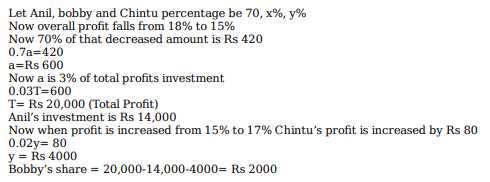
If a rhombus has area 12 sq cm and side length 5 cm, then the length, in cm, of its longer diagonal is
Video Explanation

Explanatory Answer
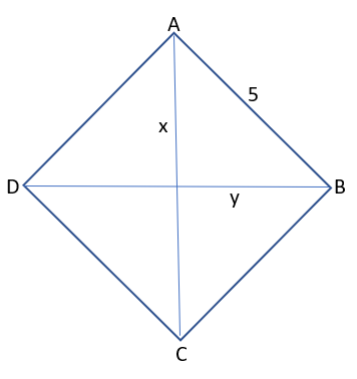
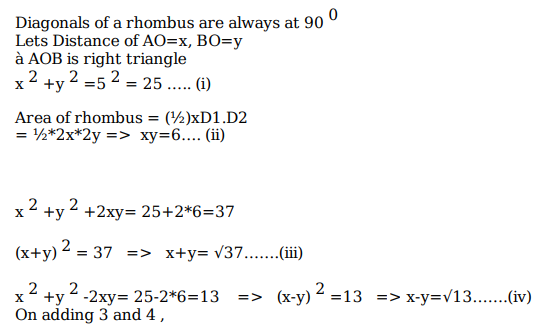

Three positive integers x, y and z are in arithmetic progression. If y − x > 2 and xyz = 5(x + y + z), then z − x equals
Video Explanation

Explanatory Answer
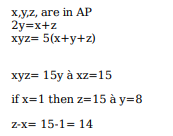
Let D and E be points on sides AB and AC, respectively, of a triangle ABC, such that AD : BD = 2 : 1 and AE : CE = 2 : 3. If the area of the triangle ADE is 8 sq cm, then the area of the triangle ABC, in sq cm, is
Video Explanation

Explanatory Answer
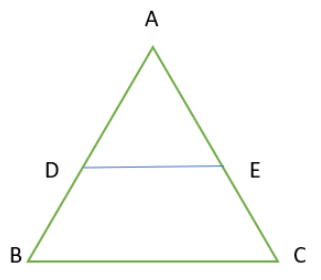
Area of Triangle ADE= (AD/AB)*(AE/AC)*(Area of ABC)
8 = (2/3)*(2/5)*(Area of ABC)
Area of ABC = 30
For a 4-digit number, the sum of its digits in the thousands, hundreds and tens places is 14, the sum of its digits in the hundreds, tens and units places is 15, and the tens place digit is 4 more than the units place digit. Then the highest possible 4-digit number satisfying the above conditions is
Video Explanation

Explanatory Answer
Let the number be abcd
a + b + c = 14 –(1)
b + c + d = 15 –(2)
c = d + 4 – (3)
Eq (2) – (1) =
d – a = 1
d = a+1 put in eq (3)
c = a + 1 + 4
c = a + 5 –(4)
Hence, ‘a’ can take max value of 4 when c = 9
Put value of c from (4) to (1)
b + 2a + 5 = 14
b = 1 (When a is max = 4)
From (3) ‘d’ can take maximum value of 5.
Hence answer is 4195
In a football tournament, a player has played a certain number of matches and 10 more matches are to be played. If he scores a total of one goal over the next 10 matches, his overall average will be 0.15 goals per match. On the other hand, if he scores a total of two goals over the next 10 matches, his overall average will be 0.2 goals per match. The number of matches he has played is
Video Explanation

Explanatory Answer
Let no. of matches = M
Average goals = A
Total goals = MA
à (MA+1)/(M+10) = 0.15
à (MA+2)/(M+10) = 0.2
(MA+1) = 0.15(M+10) ………(i)
(MA+2) = 0.2(M+10) ………(ii)
Eq (ii)- (i)
1 = 0.05(M+10)
M = 10
For all real numbers x the condition |3x - 20| + |3x - 40| = 20 necessarily holds if
Video Explanation

Explanatory Answer
|3x-20| + |3x-40| = 20
If we put x=6
2+22 does not satisfy
If we put x=14
22+2 does not satisfy
à Option A, C, D can be eliminated
Hence, 7<x<12
The sides AB and CD of a trapezium ABCD are parallel, with AB being the smaller side. P is the midpoint of CD and ABPD is a parallelogram. If the difference between the areas of the parallelogram ABPD and the triangle BPC is 10 sq cm, then the area, in sq cm, of the trapezium ABCD is
Video Explanation

Explanatory Answer
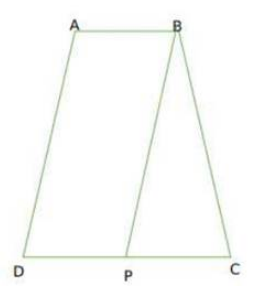
Let AB = DP = PC = x
Let the height of the parallelogram = h
Area of the parallelogram ABPD - Area of the triangle BPC = 10
xh – ½(xh) = 10
xh = 20
Area of the trapezium ABCD = xh + ½(xh) = 3/2(xh) = 30
Raj invested ₹ 10000 in a fund. At the end of first year, he incurred a loss but his balance was more than ₹ 5000. This balance, when invested for another year, grew and the percentage of growth in the second year was five times the percentage of loss in the first year. If the gain of Raj from the initial investment over the two year period is 35%, then the percentage of loss in the first year is
Video Explanation

Explanatory Answer
Initial investment = Rs 10,000
Final amount = Rs 10,000*1.35 = Rs 13500
We can take an options approach to this question
Let’s assume loss percentage as 10%
The profit percentage in @nd year will be 50%
10000*0.9 = Rs 9000
9000*1.5 = Rs 13500
à 10% is the correct answer
Two pipes A and B are attached to an empty water tank. Pipe A fills the tank while pipe B drains it. If pipe A is opened at 2 pm and pipe B is opened at 3 pm, then the tank becomes full at 10 pm. Instead, if pipe A is opened at 2 pm and pipe B is opened at 4 pm, then the tank becomes full at 6 pm. If pipe B is not opened at all, then the time, in minutes, taken to fill the tank is
Video Explanation

Explanatory Answer
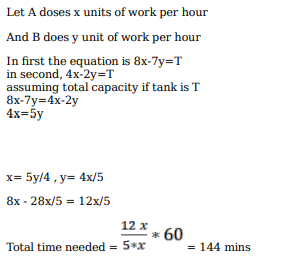
A person buys tea of three different qualities at ₹ 800, ₹ 500, and ₹ 300 per kg, respectively, and the amounts bought are in the proportion 2 : 3 : 5. She mixes all the tea and sells one-sixth of the mixture at ₹ 700 per kg. The price, in INR per kg, at which she should sell the remaining tea, to make an overall profit of 50%, is
Video Explanation

Explanatory Answer
2:3:5 and 1/6 mixture are sold
let’s assume total purchase as 60 kg
12:18:30
C.P= 9600+9000+9000= 27600
Now to get S.P. = 27600*1.5= 41400
We sold 10kg at Rs 700
41400-7000/50 = Rs 688/kg









